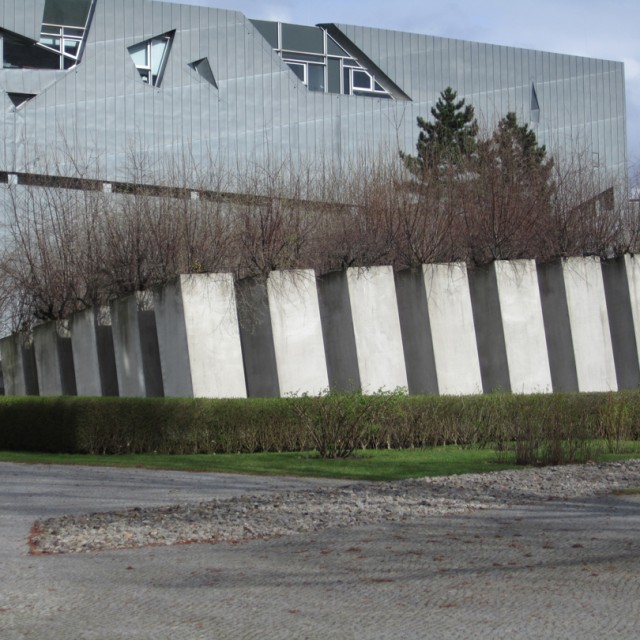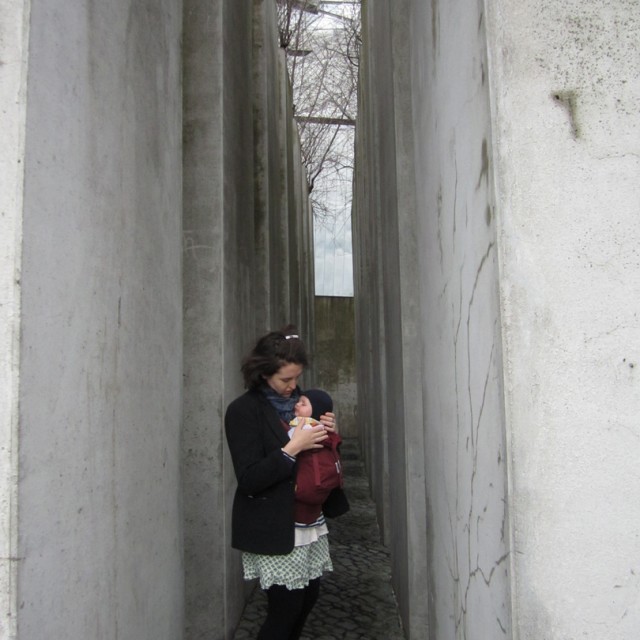The Garden of Exile
This is the Garden of Exile.
It stands outside the Jewish Museum Berlin. The garden represents the experience of European Jewish exiles, driven from their home during World War II. Standing in between the rows of forty-nine concrete container columns is a claustrophobic, disorienting experience, where you are aware that logically, escape is very close but physically, you feel as if you are trapped forever.
Daniel Libeskind designed the garden, as well as the iconic museum, which continues to attract visitors in the several thousands each year. The Jewish Museum Berlin opened on September 11, 2001. It closed shortly after due to the September 11 attacks in New York, opening to the public officially on September 13 that year. Last year it celebrated its 10th anniversary. The Museum documents European Jewish history and the overwhelming loss of Jewish history and culture due to the Holocaust during World War II.
We were some of the thousands of visitors, last week.
The garden’s columns are arranged in a square on a 12° gradient effectively disorienting and destabilizing you as you walk up and down the rows. Only when you look up and see the willow branches reaching towards the sky, dripping over the edge of the container columns, do you feel the possibility of release.
In terms of absorbing and honoring the emotion of the devastating loss of life and culture during the Holocaust, this garden, a symbolic representation, was for us, a tremendously affecting experience. A simple sculptural garden of concrete and willows conveyed more emotion combined with a physical sensation of oppression and loss than the detailed museum didactics were able to do.
In fact, the experience of the Jewish Museum Berlin was best characterized by the external rather than the internal, the Garden of Exile, the stark architecture, the stone blockades to prevent bomb attacks, the police presence, and the airport style metal detector and security checkpoint to enter. These all conveyed more of the experience of European Jewish history than what was on display.
Inside the rows of the Garden, you could hold space to remember.
Radio Aktiv Sonic Deep Map (2013)

SUPERKILEN – Extreme Neoliberalism Copenhagen Style

Read Brett's essay about the park.
Download our guide:

This is our guide to how-to books from the counterculture of the 60s and 70s. Click to get the download page.
Categories
- Agriculture (11)
- Animal sounds (1)
- Artist parents (19)
- Arts and culture (106)
- Bees (3)
- Book reviews (14)
- Books (18)
- Critical essays (5)
- Daily Photo (5)
- Design (36)
- Dirt (11)
- Environmental activism (43)
- Exhibitions (24)
- Farms (11)
- Forest (7)
- Friday connect (15)
- Growing (42)
- Habitat (38)
- Homesteading (16)
- Interviews (15)
- Kitchen (14)
- Living structure (9)
- MISC (15)
- Mythological (2)
- Neighborhood (83)
- Ocean News (1)
- Our Art Work (21)
- Personal – Design/Art (3)
- Play (2)
- Playground (4)
- Projects (21)
- Public space (53)
- Resilience (13)
- Sea Side (2)
- Sojabønner (2)
- Tofu (8)
- Vermont correspondence (7)
- Water (3)
- Wednesday picture (31)
- Workshop (1)
Video interview:

Watch our interview of SeedBroadcast, a mobile project that is part seed library and part seed-saving-story-collecting machine-recording the stories of seed saving, farming, and food sovereignty work being done around the US.

Download a poster Bonnie made about biodiversity in a vacant lot in the Amager borough of Copenhagen, in collaboration with biologist, Inger Kærgaard, ornithologist, Jørn Lennart Larsen and botanist, Camilla Sønderberg Brok: A BRIEF TAXONOMY OF A LOT

We made and installed a network of bat houses in Urbana, Illinois, to support the local and regional bat population, but also to begin a conversation about re-making the built environment.
READ MORE
BOOK REVIEW:

We write often about artists and art groups that work with putting ‘culture’ back in agriculture. Here is a new favorite: myvillages, a group of three women based in Germany, the Netherlands, and the UK. Read more...

Post Revolutionary Exercises
We really admire the dedicated hard work of Kultivator who seeks to fuse agriculture and art in their work. Click this sentence to get a PDF of their poster collection called "Post Revolutionary Exercises."

Cultural Practices Within And Across
This amazing book networks urban and rural resilience and sustainability projects around the world. Deeply inspiring projects in Romania, Paris, San Francisco, and elsewhere.
• Read our review of the book.
• Buy the book.
• Download the book.









